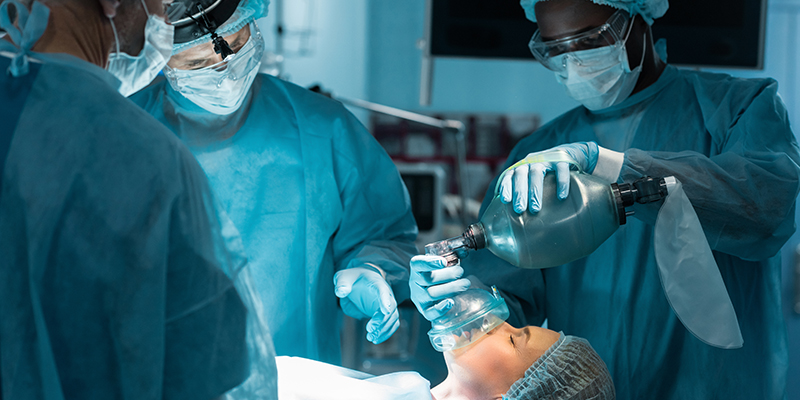Written and edited by: Mel Quist | Content Strategist at Insight
When you come to Insight Orthopedic & Sports Medicine for a procedure or surgery, anesthesia may be required to ensure the procedure is performed safely and without discomfort. There are many types of anesthesia and our team will work with you to choose the best options based on a number of factors, including the type of procedure, your current health, and your medical history. The following is an overview of anesthesia and what you can expect if anesthesia is required for your procedure or surgery.
What is Anesthesia?
Anesthesia is the use of medicines to reduce pain during surgery and other medical procedures. Also known as anesthetics, these medicines are commonly administered intravenously, through inhalation, and topically. Depending on the type of anesthesia, you may experience loss of feeling in a specific area of the body, sleep, or a loss of awareness.
Types of Anesthesia
There are several types of anesthesia used by our team at Insight Orthopedic & Sports Medicine. Whether you’re having a simple outpatient procedure or a complex surgery, it is important to understand the types of anesthetics available to you, why they’re used, and how they’re administered.
Conscious Sedation
Conscious Sedation is used to help you relax and block pain during a medical procedure. Most patients stay awake during conscious sedation but will feel drowsy. Recovery is quick and you should be able to proceed with normal activities after the procedure. This type of anesthesia is usually given intravenously or with a shot into a muscle.
General Anesthesia
General Anesthesia is used to put you in a sleep-like state during a surgery or medical procedure. Patients will be unconscious and should not feel pain because the brain will not respond to pain signals or reflexes. Recovery is gradual and patients often feel groggy, confusion, nausea, and soreness. General anesthesia is usually given intravenously or with a gas that you breathe.
Local Anesthesia
Local Anestheisa is used to temporarily numb an area of the body before a minor procedure. Patients stay awake during local anesthesia, but it may be used with a sedative to help you relax. This type of anesthesia typically wears off within an hour, but lingering numbness may be felt throughout the day. Local anesthetics are applied topically to the skin or through injection, depending on the type of procedure and size of location.
Regional Anesthesia
Regional Anesthesia is used to block pain in a large area of the body (e.g. arms and legs) without being unconscious. This type of anesthetic may be used with other medicines for relaxation and pain relief. Pain can be controlled for a few hours or longer, depending on the type of procedure. Regional anesthesia is injected to target a specific area of the body.
Monitored Anesthesia Care (MAC)
Monitored Anethesia Care (MAC) used to make patients sleepy and calm during a procedure, but awake and able to answer questions. MAC is also referred to as twilight sleep and is commonly used for outpatient procedures. This type of anesthesia wears off quickly and you should be able to wake shortly after the procedure is completed. MAC is administered intravenously.
Peripheral Nerve Block
A Peripheral Nerve Block is used to block sensations of pain in a specific area of the body, such as arms and legs, by targeting bundles of nerves. A peripheral nerve block lasts longer than local anesthesia and is typically used with other medicines to make you relax and feel sleepy. Patients are monitored closely during procedures using this type of anesthetic because it can affect the central nervous system.
What Does an Anesthesiologist Do?
Anesthesiologists are medical doctors who specialize in drugs that are used to control pain. In simple procedures requiring only local anesthetics to manage pain, the physician performing the procedure will typically administer the medication. In complex or invasive procedures, an anesthesiologist will work closely with you and your doctor to effectively manage your pain before, during, and after your procedure or surgery.
What to Expect During Surgery?
Before surgery, your anesthesiologist will evaluate your medical history, current health, and the type of procedure to develop an anesthetic plan. You will have time to meet with the anesthesiologist to ask questions, bring up concerns, and get a clear understanding about what you can expect in all stages of surgery.
During surgery, the anesthesiologist will be with you to administer the anesthetic and closely monitor you during the procedure. Some of the vital signs your anesthesiologist will monitor include heart rate, blood pressure, breathing, and body temperature. Even the smallest changes in your body’s functions will alert the anesthesiologist to adjust how the anesthetic is being administered.
What to Expect After Surgery?
As soon as your surgery is complete, the anesthesiologist will begin reversing the medications to wake you up slowly. Most patients will wake in a recovery room and will feel sleepy with some confusion. Other side effects you may experience include nausea, vomiting, dry mouth, itching, soreness, and slight pain. Your anesthesiologist will work with you to control any pain and side effects you may be experiencing. The side effects you experience usually depend on the type of surgery.

What To Tell Your Doctor
Because there is no one size fits all approach to anesthesia, communication with your anesthesiologist is key to successful surgeries and pain management. The Insight Orthopedic & SPorts Medicine team encourages patients to be forthcoming with health information so we can develop an anesthesiology plan that is right for you. Here are a few things to discuss with your anesthesia provider:
- Chronic health conditions
- Medications and supplements you take
- Cigarette, marijuana, and alcohol use
- Sleep apnea history
- Stroke history
- Past reactions to anesthesia
With advanced medicine and monitoring technology, anesthesia is generally safe. However, it is important you understand the types of anesthetics that are available, how they’re used, and what you can expect before, during, and after surgery. For more information about anesthetics or to schedule an appointment with someone from the Insight Orthopedic & Sports Medicine team, call
(810) 732-8336

